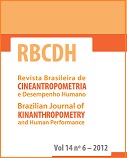Assessment of physical growth through body proportionality in Peruvian children living at moderately elevated altitudes
DOI:
https://doi.org/10.1590/1980-0037.2012v14n6p690Abstract
The strategy of our approach involves the use of an instrument for measuring body proportionality for the purpose of comparing growth of segments to body dimensions. The objective of this descriptive transversal study is to assess physical growth through body proportionality of school children, aged 6 to 12 years, living at moderately elevated altitudes. Study participants included 482 females and 473 males ranging in ages from 6 to 12 years and possessing middle socioeconomic status. The students were selected from a stratified probability segment of 6,659 students. In all, we evaluated: anthropometric measurements of weight (kg), height (m), five skinfolds (mm), four body perimeters and four body-bone diameters. Proportionality analyses were performed using the Phantom theoretical model proposed by Ross and Wilson (1974). The results of the Phantom Z-scores for both genders show generally negative values for body weight (-3.7 to -1.7), skinfold thickness (0.5 to -1.5), and body circumference (-0.9 to -1.3). In turn, bone diameters show positive values in all ages as well as in both genders (1.0 to 3.2). The results suggest that school children living at moderately elevated altitudes are characterized by slow growth correlated to body weight; on the other hand, skinfold thicknesses and body circumferences in relation to bone diameters exhibit a tendency to robustness.



